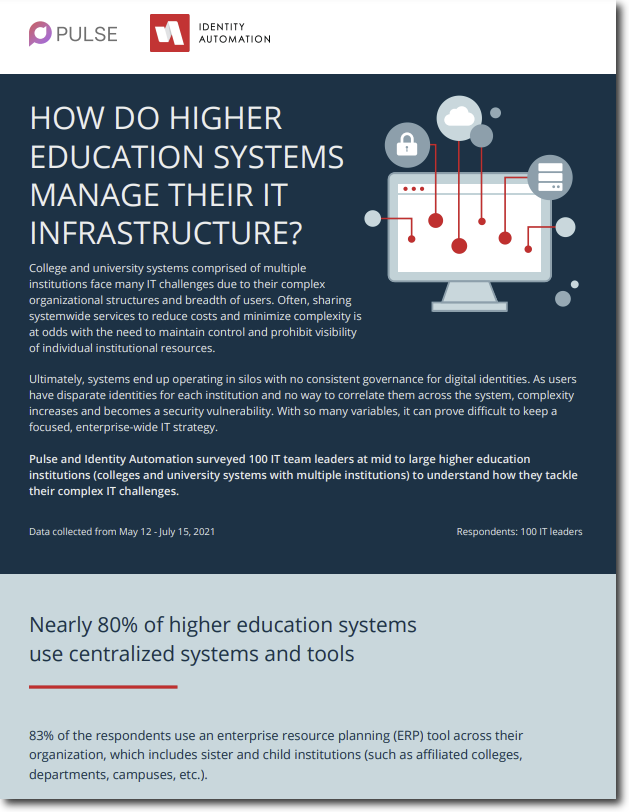
College and university systems comprised of multiple institutions face many IT challenges due to their complex organizational structures and breadth of users. Often, sharing systemwide services to reduce costs and minimize complexity is at odds with the need to maintain control and prohibit visibility of individual institutional resources.
Ultimately, systems end up operating in silos with no consistent governance for digital identities. As users have disparate identities for each institution and no way to correlate them across the system, complexity increases and becomes a security vulnerability. With so many variables, it can prove difficult to keep a focused, enterprise-wide IT strategy.
We partnered with Pulse to survey 100 IT team leaders at mid to large higher education institutions (colleges and university systems with multiple institutions) to understand how they tackle their complex IT challenges.
Let's dive right into our findings!
Nearly 80% of higher education systems use centralized systems and tools
83% of the respondents use an enterprise resource planning (ERP) tool across their organization, which includes sister and child institutions (such as affiliated colleges, departments, campuses, etc.).
78% have at least one central service application tool, such as a student information system (SIS) or a library system that is used enterprise-wide.
83% of the respondents employ a central service agency to support their end-users with account access needs and issues.
60% of higher education systems still rely on manual processes or homegrown scripts
Only 3-5% of survey respondents leverage automatic cloud identity services to provision or deprovision internal and external users. Nearly a third of the respondents (31%) use manual processes to manage external users and 20% manually administer internal users.
60% of survey respondents rely on manual processes or homegrown scripts to provision or deprovision internal and external users. Of the remaining 40% of respondents that use a solution or service, 37% are on-premises identity and access management (IAM), which means the institution is responsible for maintenance, upgrades, upkeep, and development.
80% of the IT leaders admitted that it takes their teams more than a day to deprovision accounts. Worryingly, for over a quarter (27%), it takes longer than 4 days.
Complex identity management creates bottlenecks as 91% of new hires wait a day or more to receive access
Higher education institutions frequently must manage users with multiple affiliations or personas, such as students that are also staff or faculty that hold positions at multiple campuses. To handle these varying user access matrices, more than half of the IT leaders admitted that they simply administer different logins for these multifaceted users (65% for students and 76% for employees).
For 91% of respondents, new hires at their organization must wait a full day or more to get access to everything they need to do their job.
RapidIdentity— IAM Tailored for Higher Education Systems
With continuous strands of students and staff moving in and out of college and university systems, identity management can quickly become a tangled web. Identity-related tasks, such as delegating administrative access to critical systems and managing access for guests, contractors, and other third-party affiliates, simply aren’t manageable at scale— without the right technology.
Identity Automation helps higher education systems overcome these challenges with RapidIdentity Distributed Identity and Access Management (IAM).
Designed to address the unique needs of higher education systems, Distributed IAM leverages a common, central Identity Governance and Administration (IGA) service to enable both parent organizations and affiliates to benefit from the efficiency of shared services, while still providing the flexibility to maintain independently owned services.
Download the full whitepaper here.


Comments